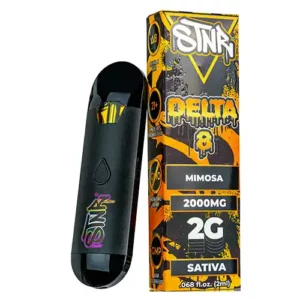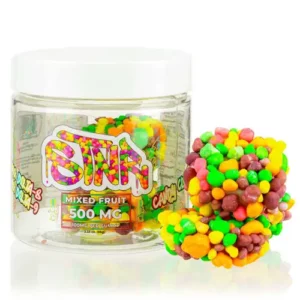The debate around Delta 8 vs Delta 9 isn’t going anywhere. If you’ve been floating through the world of hemp and THC products, you’ve definitely seen these two pop up everywhere, on gummies, carts, vapes, and everything in between.
But even though they sound similar, Delta 8 and Delta 9 are not the same. They hit differently, feel differently, and come with their own unique vibe. This guide is here to break it down for real.
We’re not gonna hit you with fluff or vague takes. Just the raw truth about what sets these two cannabinoids apart, how they affect your body, and why some people ride with one over the other. By the time you’re done here, you’ll know exactly what’s up with Delta 8 vs Delta 9—and which one belongs in your stash.
STNR Creations and their Delta 9 lineup hits hard. First time? Make it better with 20% off using code sly420ng.
What Is Delta 8?

Delta 8 is a naturally occurring cannabinoid found in cannabis and hemp, but in very small amounts. Most of the Delta 8 on the market is converted from CBD using a chemical process because it’s easier to get that way. Chemically, it’s almost identical to Delta 9—just one tiny difference in a double bond. But that small change makes a big difference in how it feels.
People who use Delta 8 describe it as the more mellow cousin of Delta 9. You still get high, but it’s smoother, gentler, and less intense. The high doesn’t smack you in the face—it eases you into a floaty, clear-headed state. That makes it perfect for daytime use, creative work, or just keeping it chill without going full space cadet.
Delta 8 is also known for causing less anxiety and paranoia. If you’ve ever had a Delta 9 experience that went sideways, Delta 8 might be your second chance. It gives you the body relaxation and mental uplift without the overwhelming intensity that sometimes comes with Delta 9.
Legally, Delta 8 is in a weird spot. Because it’s derived from hemp and contains less than 0.3% Delta 9 THC, it’s legal under federal law. But some states have banned it altogether. So yeah, it exists in that legal gray area. Always check your local laws before you stock up.
In terms of products, you’ll find Delta 8 in gummies, vapes, tinctures, and even dabs. The effects usually kick in slower than smoking Delta 9 but faster than traditional edibles. And the high? It’s functional. You’re stoned, but still in the driver’s seat.
What Is Delta 9?
Now let’s talk about the heavy-hitter: Delta 9 THC. This is the main psychoactive cannabinoid in cannabis. It’s what gives you that classic weed high—euphoria, deep body chill, time distortion, all of it. Delta 9 is the OG. It’s been around forever, and it’s still the standard by which all other cannabinoids are measured.
When you take Delta 9, whether it’s by smoking flower, hitting a cart, or munching on a gummy, it binds with your brain’s CB1 receptors fast. That’s why the effects are strong and quick. It’s a full-body, full-mind experience. The intensity can be overwhelming if you’re not used to it, but it’s also what makes it so powerful.
Delta 9 has the kind of psychoactive punch that turns a regular night into a memory. The high is more immersive than Delta 8—it pulls you in deeper, whether that means sinking into the couch or laughing for 45 minutes straight at absolutely nothing.
Because it’s more potent, Delta 9 also comes with a higher chance of side effects. That includes anxiety, dry mouth, red eyes, and paranoia if you overdo it. But if you get the dose right, the ride is unforgettable. It’s the kind of high that artists chase, that introverts need to recharge, and that seasoned smokers swear by.
Legally, Delta 9 is a bit more restricted. In its traditional cannabis form, it’s only fully legal in states with medical or recreational weed laws. But thanks to the 2018 Farm Bill, hemp-derived Delta 9 (with less than 0.3% THC by dry weight) is federally legal, and that’s opened the door for legal edibles and vapes that still pack a punch.
You’ll find Delta 9 in flower, gummies, tinctures, carts, chocolates, and drinks. It’s everywhere, and for good reason. If you want the full THC experience and don’t mind going deep, Delta 9 delivers every single time.
Delta 8 vs Delta 9: Effects and Intensity
Now that you know what they are, let’s talk about how they feel. The core difference between Delta 8 vs Delta 9 is intensity. Delta 9 hits harder and faster. It’s more psychoactive, more immersive, and longer-lasting. Delta 8, on the other hand, is smoother. It’s a softer high with fewer peaks and valleys.
Delta 8 gives you mental clarity with a side of relaxation. Delta 9 gives you euphoria with a side of holy sh*t. That’s not a bad thing—it just depends on what kind of experience you’re chasing. Want to feel creative but in control? Go Delta 8. Want to dive deep into your couch and forget about everything for a bit? Delta 9’s got you.
One isn’t better than the other. They just serve different purposes. Some people even alternate based on their plans. Delta 8 for workdays or chill hangs. Delta 9 for nights, weekends, and turning all the way off. It’s all about picking the right tool for the job.
Another thing to keep in mind: Delta 9 tends to build tolerance faster. If you use it a lot, you’ll need more to get the same effect. Delta 8 users report a slower tolerance build-up, which is nice if you’re trying to keep your usage low-key.
Bottom line? Delta 9 is more intense, with stronger effects and a faster onset. Delta 8 is more mellow, with a smoother high that’s easier to manage for beginners or casual users. Choose wisely, and the high will treat you right.
Delta 8 vs Delta 9: Availability and Products

You can find both Delta 8 and Delta 9 in a ton of different forms. Gummies, vapes, tinctures, dabs, drinks—you name it. But depending on where you live, one might be easier to get than the other.
Delta 8 exploded first because of the federal hemp loophole. Brands jumped on it fast and dropped a ton of product. You can find Delta 8 carts and gummies almost everywhere, from smoke shops to gas stations. Just be careful—some brands cut corners. Always look for third-party lab tests.
Delta 9, especially the hemp-derived version, came next. Edibles were the big push here. Since gummies and chocolates are heavy, brands figured out how to legally dose them with 10mg or more of Delta 9 and still stay under the 0.3% weight limit. That’s why you’re seeing legal Delta 9 gummies everywhere now.
Both types are legal at the federal level when derived from hemp, but state laws vary. Some states banned Delta 8 altogether. Others limit the types of Delta 9 products you can buy. Always check your local rules so you don’t end up on the wrong side of the law.
If you’re shopping online, stick with brands that post lab results and list exact dosages. Whether it’s Delta 8 or Delta 9, quality control matters. You want consistency, potency, and clean ingredients. Anything less isn’t worth your money—or your high.
Final Word: Choosing Between Delta 8 and Delta 9
So here’s the final word on Delta 8 vs Delta 9. Both cannabinoids have their place. Delta 8 is laid-back, manageable, and great for people who want a lighter, functional high. Delta 9 is bold, intense, and perfect for experienced users who want to go all in.
It’s not a competition. It’s a choice. Pick what works for your vibe, your tolerance, and your plans for the day. Some days call for Delta 8. Others demand Delta 9. The real win? Knowing how to use both like a pro.
Whatever you choose, make sure it’s clean, lab-tested, and from a brand that knows what it’s doing. Because no matter which cannabinoid you ride with, quality makes all the difference. Stay lifted, stay smart, and enjoy the ride.
